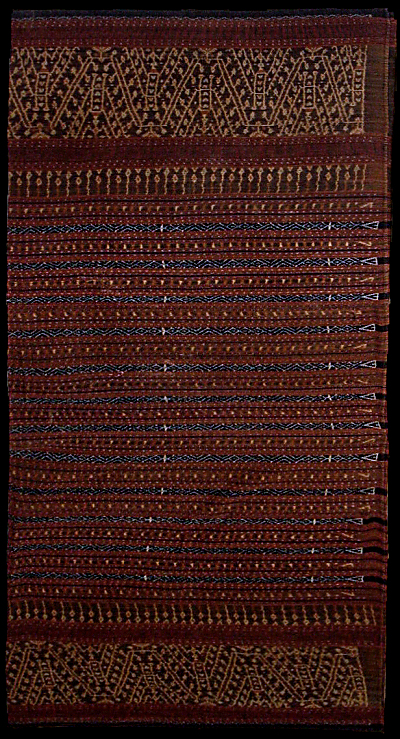| |
 
 | | | |
021 Flores Group, Lio
Lawo (sarong)
| | Locale: | Nggela or nearby village | | Period: | 1930-1950 | | Yarn: | Cotton, commercial, fine, double-ply | | Technique: | Warp ikat | | Panels: | 4 | | Size: | 75 x 186 cm (2' 5" x 6' 1") LW: 2.48 | | Weight: | 795 g (28.0 oz), 285 g/m2 (0.93 oz/ft2) | | Design: | Lawo mogha mité, so named after the twelve 'black', actually indigo, bands. The design is unusual in that normally the widest ikated bands, near the extremities, would also be indigo. The design of the widest ikated bands is called keli mara, and is supposed to symbolize Mount Mara, a hill west of nearby Ende, though this may well be a relatively modern interpretation of an archaic motif that came from elsewhere. A pretty detail is that the keli mara motif has small accents in pale indigo, much lighter than the 'black' areas, which means that they must have required a separate dye bath. Another nice touch is that the dark selvedges have been decorated with a string of fine arches, done in ikat only two threads wide. | | Comment: | [PHOTOGRAPHY PROVISIONAL] A fine example of the creativity of Lio weavers, who often create variations on established patterns by bringing in elements of another design type. The most minute elements - such a the patterns in white on indigo that recall the stippling drawing technique of Palu'e - were ikated on skeins comprising merely six threads: three for each panel. Microscopic inspection shows a fraying of the fibre commensurate with the cloth's estimated age. | | Background: | Chapters on Flores Group and Lio. | | Published: | Ikat Textiles of the Indonesian Archipelago, 2018. | | Compare: | 082 099 203 | | Sources: | Similar cloth in Hamilton, Gift of the Cotton Maiden, Fig. 6-27, except that here the wide end panels have been done, not in indigo but in morinda on a background in an ochre-like yellow, probably created with a bath of kayu kuning. The same applies to example in the National Gallery of Australia, NGA 1981.1143. The motifs in this wide band are the same that we see in sarongs of the type lawo keli mara. | | |

©Peter ten Hoopen, 2024
All rights reserved.
|
|


